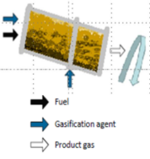Gasification
Gasification is the thermal breakdown of a material into a gas via partial oxidation under the application of heat. It Involves the sub-stoichiometric oxidation or steam reformation of a substance to produce a gaseous mixture containing two or more of the following: (i) oxides of carbon, (ii) methane and (iii) hydrogen[1]. The gas is then generally burnt to raise steam and create electricity, but many plants are exploring the option of cleaning the gas for use in a gas engine or separating the gas into usable fractions such as hydrogen for use, as an example, of liquid fuels which in turn may be eligible under the RTFO.
Gasification can be considered a process between Pyrolysis and conventional EfW in that it involves the partial oxidation of a substance. This means that oxygen is added but the amounts are not enough to allow the fuel to be completely oxidised and full combustion to occur. The temperatures employed are typically above 650°C. Generally, the Syngas generated from Gasification will have a Net Calorific Value (NCV) of 4-10MJ/Nm3 [2].
Autothermal Gasifiers
Autothermal (direct) gasifiers provide the necessary heat of conversion by adding an oxidant to achieve partial oxidation of the fuel within the gasification reactor. This releases energy directly in the reactor where it is consumed. Autothermal conditions are easy to achieve using air or oxygen. Overall the complexity of the process is reduced compared to allothermal gasifiers, however the heat release occurs in the zone of contact between the oxidant and a combustible which requires a good internal heat transfer to even out the temperature or causes a temperature gradient inside the gasifier.
Types of autothermal gasifier:
- Co-current flow (downdraft) moving bed gasifier
- Co-current flow (updraft) moving bed gasifier
- Kiln/tunnel gasifier
- Grate gasifier
- Fluidised bed gasifier
- Entrained flow
Co-current flow (downdraft) moving bed gasifier

Downdraft moving bed gasifiers have fuel feeding from the top and the bed formed moves slowly downward while the fuel forming the bed undergoes drying and pyrolysis in fairly well-defined zones as it gradually approaches the lower and hotter parts of the gasifier. The moisture evaporated pyrolysis gases generated also flow downwards co-currently with the moving bed. The oxidant (almost exclusively air) is injected around the circumference of the gasifier just above, or in the throat (the lower part of the gasifier that has a smaller circumference). The air reacts with char and gases present to create an incandescent char bed glow zone at approximately 1 000°C. The tar-laden pyrolysis gases pass through the pores of this glowing bed and the temperature and contact with the char causes decomposition of the tars. In addition, steam and CO2 in the gas react with the char producing additional hydrogen and carbon monoxide. The product gas continues further downward and leaves the gasifier just above the grate at the bottom of the vessel at approximately 800°C which is controlled by the air injection. Ash and unreacted char fall through the grate and are removed.
Co-current flow (updraft) moving bed gasifier

In moving bed updraft gasifiers, the oxidant (most often air) is injected at the bottom of the gasifier and the product gas flows upward and exits at the top of the gasifier. In such gasifiers well-defined temperature zones are established, from the fuel drying section at the fuel inlet, the pyrolysis zone beneath the drying zone and the reduction zone where the combustion gases react with the char from pyrolysis and finally the combustion or glow zone at the bottom where the oxidant (air or oxygen combined with steam) is injected. The final burn-out of the char occurs on a moving grate through which the ash falls through into the ash outlet. The hot product gas from the glow zone going upwards is the heat carrier that heats up the fuel to reach the temperature to achieve pyrolysis and the drying prior to extracting the cooler gases at the top at a temperature where excessive tar condensation does not occur (typically at 200-400 °C).
Kiln/tunnel gasifier

In kiln or tunnel gasifiers, the fuel is fed co-currently with the oxidant (typically air), being heated and pyrolyzed while moving through the reactor. The difference to the co-current downdraft reactor is that in this case the movement in the kiln or channel generates more or less mixing in the bed of solids than in the moving bed.
Grate gasifier

Grate type gasifiers that resemble updraft moving bed gasifiers, i.e. the fuel is moved as a bed on an inclined or moving grate, or on a belt in a furnace tunnel while the oxidant is added from below, such that drying and pyrolysis occurs close to the feed point and burn-out of the char at the ash exit point. This is a kind of cross-flow arrangement where the product gases from all sections in an updraft gasifier is generated separately and then mixed, unlike the counter current passage of the gas from one section through the next in an updraft gasifier.
